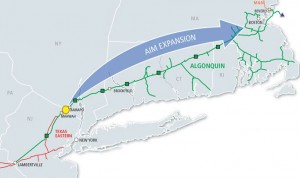Technology problems and miscommunication impeded an effort by boisterous opponents of a natural gas pipeline project in a conference call last week with a federal agency to discuss recently released documents about the project”™s approval.
The call ”“ which was difficult to hear because of a poor connection ”“ was intended to discuss new information related to a petition filed by engineer and nuclear consultant Paul Blanch last year that raised concerns about the proximity of the Algonquin natural gas pipeline to Indian Point Energy Center, the nuclear power plant in Buchanan. Blanch and pipeline opponents have called for the pipeline plan”™s approval to be rescinded and for an independent risk assessment, saying there were numerous flaws with the released safety report.
The documents, which were unavailable to the public until a few weeks ago and classified as “security sensitive,” became available as the result of Freedom of Information Act requests filed by Blanch and advocacy group Stop the Algonquin Pipeline Expansion. The papers outlined the safety evaluation provided by plant owner Entergy Corp. in the event of a pipeline explosion and emails associated with the report between officials at the Nuclear Regulatory Commission.
Not all the documents used to assess the safety of the plant in the event of a pipeline rupture were provided to Blanch or the protest group.
Blanch and Richard Kuprewicz, an appointed member of the U.S. Department of Transportation Technical Hazardous Liquids Pipeline Safety Standards Committee, had anticipated having an open dialogue with the Nuclear Regulatory Commission on Wednesday about the safety evaluation report released by the agency but were told by NRC officials during the public phone call that the officials could not answer questions, only receive additional information from the petitioners.
This and the frustration from communication difficulties led to heightened tensions among protesters in the conference room and at least one person walking out of the Hendrick Hudson Free Library in Montrose.
Representatives for Entergy and the NRC have said the analyses each organization conducted were commissioned independently.
Blanch, in his presentation to the NRC about the explosion scenario analysis, questioned what he called an unidentified variable in the paperwork, the validity of a handwritten component and the lack of discussion of vapor clouds ”“ floating gas from a leak that could ignite and cause an explosion.
“I have 20 questions; is it even worth asking?” Blanch said during the phone call to NRC officials. With encouragement from the audience, Blanch read his 20 questions for the record and will be submitting them in writing.
As part of the petition process with the NRC, spokesman Neil Sheehan said, “We”™ll look at the information he put forward and to see if that changes our decision on allowing this petition to proceed further.”
NRC representatives on the phone Wednesday repeatedly said the purpose of the call was for Blanch and Kuprewicz to provide additional information, not ask questions.
At one point, an NRC official said, “I think it may be more productive if we ask the questions.”
“It went pretty much as expected,” Blanch said in a follow-up phone call, and added that he has plans to talk to the state inspector general about the issue. “We”™re going to continue to demand there”™s an independent risk assessment.”
Entergy wrote in a statement that the company “takes no position on the pipeline itself” and worked with pipeline owner Spectra Energy Partners LP to “add enhanced protective measures like increasing the thickness of the pipe, burying the pipe deeper and laying concrete protective mats over the pipe in the vicinity of the power plant.”
The Federal Energy Regulatory Commission authorized the $971.6 million project in March to expand and replace parts of the existing pipeline in a plan referred to as the Algonquin Incremental Market Project. The approval by FERC was partially contingent on safety evaluations by the NRC and Entergy.
In the final environmental impact statement, FERC agreed with the safety analysis conducted by Entergy and confirmed by the NRC. FERC wrote that “a breach and explosion of the proposed 42-inch-diameter natural gas pipeline would not adversely impact the safe operation of the (Indian Point) facility.”
The Petition Review Board at the NRC will take into consideration the new information presented by Blanch and Kuprewicz and determine whether to move forward in the petition process.




















Comments 1